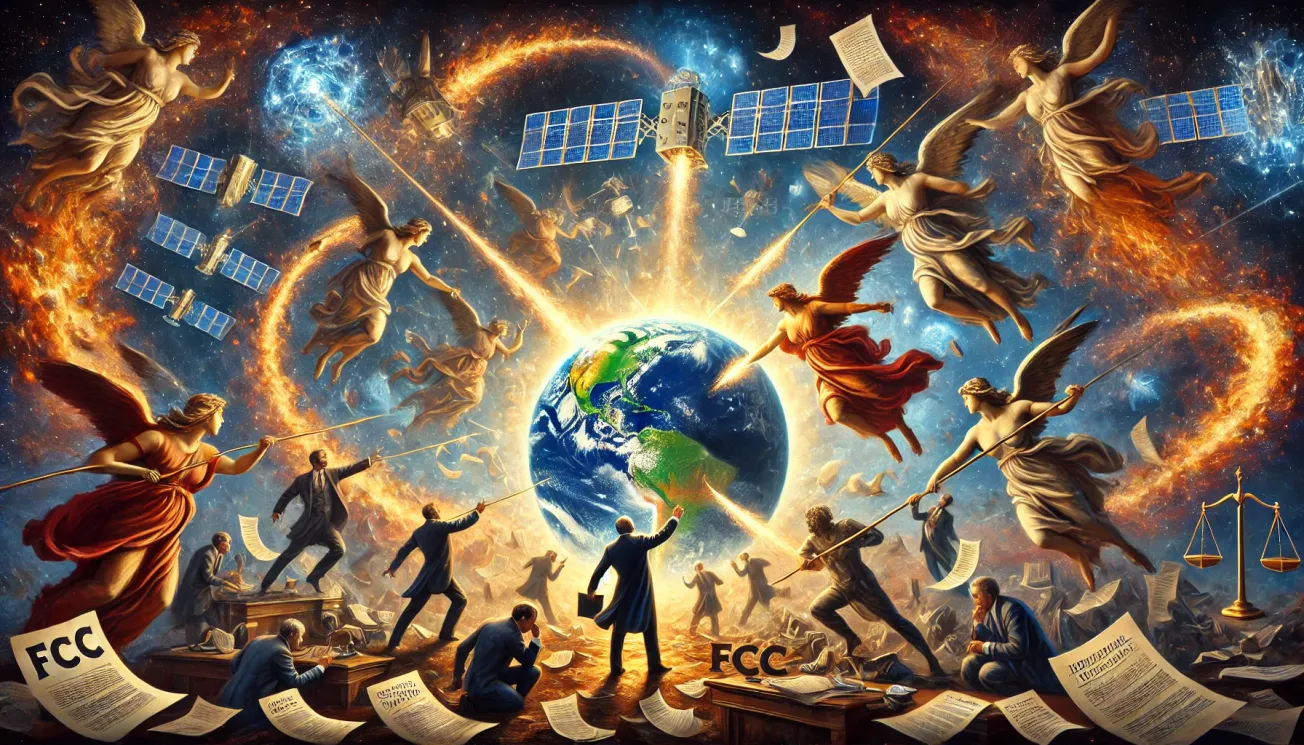Table of Contents
Introduction
Since its inception, Starlink has positioned itself as a revolutionary force in global internet access, promising to bring high-speed broadband to even the most remote corners of the planet. Powered by SpaceX’s vast constellation of low Earth orbit (LEO) satellites, Starlink has disrupted the traditional broadband industry, challenging fiber and terrestrial ISPs with its scalable, satellite-based approach.
However, none of this would have been possible without the approval of the Federal Communications Commission (FCC), the U.S. regulatory agency that controls spectrum allocation, licensing, and broadband subsidies. Every satellite launched, every frequency used, and every attempt to expand Starlink’s services requires FCC authorization, making the agency one of the most critical factors in Starlink’s long-term success.
Despite their interdependence, the relationship between Starlink and the FCC has been anything but smooth. From spectrum disputes to funding battles and regulatory roadblocks, SpaceX has frequently clashed with the agency over rules that could slow its expansion. At the same time, the FCC has relied on Starlink as a key player in its efforts to bridge the digital divide, granting emergency approvals and testing satellite broadband for underserved communities.
As Starlink continues to grow, its relationship with the FCC will determine its future in the U.S. broadband market. Will the FCC help or hinder its progress? And how much influence does Elon Musk’s growing network of government contracts and regulatory battles play into Starlink’s success?
In this article, we’ll explore the full history of Starlink and the FCC—from their early collaborations to their biggest conflicts, the latest political controversies, and what the future holds for this high-stakes regulatory battle.
Why the FCC is Essential to Starlink’s Success
Before diving into their conflicts, it’s important to understand why Starlink cannot operate without FCC approval. The agency plays a pivotal role in whether Starlink can expand, compete, and even function legally in the U.S.
📡 Key Areas Where the FCC Controls Starlink’s Fate:
✔ Licensing: Every Starlink satellite must receive FCC approval before launching and operating in U.S. airspace.
✔ Spectrum Allocation: The FCC decides which frequencies Starlink can use, impacting speeds and reliability.
✔ Broadband Subsidies: Government funding programs like the Rural Digital Opportunity Fund (RDOF) determine whether Starlink can expand into rural America with financial support.
✔ Regulations on Orbital Traffic: The FCC helps set space debris mitigation policies, directly affecting Starlink’s satellite deployment strategy.
Without the FCC’s regulatory green light, Starlink would be unable to function as a legal broadband provider in the United States. Yet, despite its dependence on the FCC, SpaceX has repeatedly found itself at odds with the agency over regulatory policies, competitive disputes, and funding decisions.
In the next section, we’ll explore how the FCC and SpaceX’s relationship began, detailing the first approvals and agreements that allowed Starlink to take off.
Early Interactions and Approvals: How Starlink Got Off the Ground
Starlink’s journey began long before its first satellites reached orbit. As a communications provider operating in U.S. airspace, SpaceX had to navigate a complex regulatory process before it could legally offer broadband service. The FCC was the gatekeeper, determining whether Starlink could move forward or be stalled indefinitely.
In 2016, SpaceX filed its first application with the FCC, seeking permission to deploy and operate a constellation of low Earth orbit (LEO) satellites to provide global internet coverage. At the time, LEO-based satellite broadband was largely unproven, with most existing satellite internet providers (such as HughesNet and ViaSat) operating from geostationary orbit (GEO), much farther from Earth.
📡 2016: SpaceX’s First Licensing Requests
✔ SpaceX proposed a constellation of 4,425 satellites—an unprecedented scale for any private company.
✔ The FCC expressed concerns over potential spectrum interference with existing satellite operators.
✔ SpaceX assured regulators that Starlink’s satellites would operate at lower altitudes, reducing congestion in geostationary bands.
After two years of regulatory reviews and revisions, the FCC officially granted SpaceX approval in March 2018 to begin deploying its first batch of Starlink satellites. This was a major milestone, allowing SpaceX to move from concept to reality.
🚀 2018: First Deployment Approvals
✔ The FCC approved 4,425 Starlink satellites in LEO, marking the first major step toward a global satellite broadband network.
✔ The agency imposed conditions to address potential concerns about orbital debris and frequency interference.
✔ SpaceX committed to deorbiting defunct satellites within five years, ensuring Starlink would not contribute to the growing problem of space debris.
In May 2019, SpaceX launched its first 60 Starlink satellites, officially beginning its commercial satellite broadband rollout. The FCC’s approval had paved the way for Starlink to become a real competitor in the U.S. broadband market.
However, as Starlink’s ambitions grew, so did regulatory challenges. While SpaceX had secured initial FCC approvals, it soon found itself increasingly at odds with the agency over funding, spectrum access, and competitive policies.
In the next section, we’ll explore the biggest conflicts between Starlink and the FCC—battles over funding, spectrum allocation, and regulatory resistance to SpaceX’s rapid expansion. 🚀
Key Conflicts Between Starlink and the FCC
As Starlink expanded, its relationship with the FCC grew more contentious. While the agency had been instrumental in approving Starlink’s initial launch, conflicts emerged over funding, spectrum allocation, and regulatory restrictions that threatened to slow SpaceX’s rapid deployment.
From multi-billion-dollar broadband subsidies to disputes with competitors over radio frequencies, Starlink and the FCC found themselves on opposing sides of some of the most critical policy decisions in the satellite broadband industry.
📌 1. The $900 Million RDOF Dispute: FCC Awards, Then Revokes Starlink’s Subsidy
One of the biggest conflicts between Starlink and the FCC revolved around the Rural Digital Opportunity Fund (RDOF)—a federal program designed to subsidize internet providers bringing broadband to underserved areas.
🚀 2020: FCC Awards SpaceX $885 Million in RDOF Subsidies
- SpaceX won nearly $900 million in funding from the FCC’s RDOF initiative, beating out fiber and terrestrial broadband providers.
- The award signaled government confidence in Starlink’s ability to deliver internet to rural America.
- Competitors, including cable and fiber providers, immediately protested, arguing that satellite internet was an inferior long-term solution compared to fiber infrastructure.
⚠️ 2022: FCC Reverses Course—Revokes Starlink’s Funding
- The FCC rejected Starlink’s subsidy, claiming the service was “too expensive” and had not demonstrated sufficient performance improvements.
- Jessica Rosenworcel, FCC Chairwoman, stated that “we need networks that are fast and will stand the test of time, not ones still developing technology.”
- SpaceX responded angrily, arguing that the decision was politically motivated and biased toward fiber providers, despite Starlink already serving hundreds of thousands of rural customers.
📡 Why This Conflict Matters:
- The FCC’s decision cost Starlink nearly $900 million, slowing its rural broadband expansion.
- It raised questions about whether satellite broadband is treated unfairly compared to traditional fiber networks.
- The dispute exposed tensions between SpaceX and government regulators, setting the stage for more FCC-Starlink clashes.
📌 2. Spectrum Battles: Starlink vs. Dish Network & Competitors
Starlink's success depends on securing access to wireless spectrum—the radio frequencies that satellites use to transmit internet data. However, many companies compete for the same frequencies, leading to legal and regulatory disputes.
🚀 Starlink vs. Dish Network: The 12 GHz Battle
- SpaceX and Dish Network fought a multi-year battle over the 12 GHz frequency band, which both companies wanted to use.
- Dish wanted to use 12 GHz for 5G, arguing it would benefit millions of mobile customers.
- SpaceX countered that allowing Dish to use 12 GHz would disrupt Starlink’s internet service.
⚖️ FCC’s Ruling in 2023:
- The FCC sided against SpaceX, blocking Starlink from exclusive use of the 12 GHz spectrum.
- Elon Musk publicly criticized the decision, calling it an attempt to slow Starlink’s progress.
- SpaceX warned that interference from 5G networks could degrade satellite internet quality for rural users.
📡 Why This Conflict Matters:
- Losing the 12 GHz battle forced SpaceX to rely on alternative frequency bands, limiting its ability to scale bandwidth.
- Future spectrum battles could impact Starlink’s internet speed and reliability.
- The FCC’s decision was seen as favoring terrestrial providers, intensifying Starlink’s complaints about regulatory bias.
📌 3. Regulatory Delays on Satellite Deployment
As SpaceX rapidly launched thousands of satellites, competitors filed complaints with the FCC demanding stricter regulations on Starlink’s operations.
🚀 Amazon’s Project Kuiper and OneWeb Push Back Against Starlink
- In 2021, Amazon’s Project Kuiper (a planned satellite broadband network) petitioned the FCC to block SpaceX’s request to modify its Starlink satellite orbits.
- Competitors argued that Starlink’s satellites were crowding low Earth orbit and making it harder for new companies to launch satellites.
- The FCC approved SpaceX’s request, but imposed additional conditions to reduce the risk of orbital congestion.
📡 Why This Conflict Matters:
- Starlink’s ability to quickly launch satellites gives it an advantage over slower-moving competitors, but it also creates tensions in the regulatory landscape.
- The FCC is caught between encouraging satellite innovation and preventing a single company from dominating space-based broadband.
📌 4. Political Controversies & Musk’s Growing Influence on Federal Agencies
By 2025, Starlink’s regulatory battles took a political turn, as Musk’s companies faced growing scrutiny over their influence in Washington.
🚀 2025: White House Installs Starlink for Improved Connectivity
- Reports surfaced that the Biden administration installed Starlink at the White House to improve Wi-Fi service.
- Critics questioned whether this created a conflict of interest, given ongoing regulatory disputes between Starlink and the FCC.
- Some lawmakers called for an investigation into Musk’s level of access to federal agencies.
⚠️ Political Fallout & Investigations
- March 2025: Democratic senators demanded an official investigation into Musk, questioning whether his companies were receiving preferential regulatory treatment.
- April 2025: The head of the FCC’s Broadband Equity, Access, and Deployment (BEAD) program resigned, citing frustrations over a policy shift toward satellite broadband over fiber—a move that many viewed as favoring Starlink.
📡 Why This Conflict Matters:
- Starlink’s regulatory disputes are now entangled in political battles, making its future approvals more complicated.
- Musk’s influence over government broadband policy is facing new levels of scrutiny, which could impact Starlink’s ability to operate freely.
Conclusion: Can Starlink and the FCC Work Together?
While Starlink’s success depends on the FCC’s approvals, the relationship has become increasingly strained due to:
✔ Revoked broadband subsidies that cost Starlink nearly $900 million.
✔ Spectrum battles with competitors that led to regulatory setbacks.
✔ Political scrutiny of Musk’s influence over government contracts.
🚀 What Comes Next?
- Will the FCC impose stricter rules on Starlink?
- Will political pressure slow down Starlink’s U.S. expansion?
- Or will regulators recognize that satellite broadband is essential for rural connectivity?
The future of Starlink and the FCC remains uncertain, but one thing is clear: the regulatory battles between SpaceX and the U.S. government are far from over.










